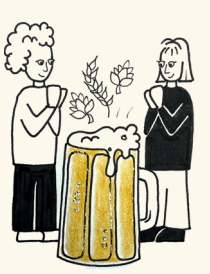Meet the extras
You can have a lot of fun with fruit and spices in beer. It’s not a new method, of course, brewers throughout the ages have added whatever they find in their local environment to flavour beer. Before the widespread use of hops, yarrow and heather were common in the British Isles for example. Belgians have long used cherry and raspberry to add a sweetness and balance to their sour lambic beers.
For the homebrewer, the availability of spices and fruits from around the world means we have an infinite variety of flavours to play with. But it’s not a matter of just lobbing in a few cherries and getting a lovely, blushed beer out the other end. Different additions act in very different ways, and it’s all dependent when you add them too: in the kettle or in the fermenter?
FRUIT
There are a couple ways in which fruit is used in beer. One is to put the fruit at the centre stage, such as in a Belgian kriek where the cherries dictate the beer. A second method is to lift the flavours already provided by the hops, hence the popularity of adding grapefruit to big American IPAs to boost the aroma already present. A third is to add a natural tartness to the beer. However, when using fruit, the effect is often very subtle. It is often best to use lightly-hopped pale or wheat beers if you are adding fruit.
If adding fresh fruit, freeze and thaw it to room temperature first. Puree rather than fruit juice is probably the best bet for adding loads of flavour, and citrus zest is also a common addition. It’s nearly always best to add your fruit during secondary fermentation.
The addition will cause another and usually rapid fermentation, so leave plenty of room at the top and also ensure that the airlock isn’t blocked. If you’re bottling a beer with fruit that hasn’t fully fermented beware of bottle bombs. The final word is that beer with fruit added works best when it has aged considerably. Open the first after a month, but leave some for at least six months and make notes. It’s not easy when homebrewing to get the profile of a fruit beer right first time.
SPICES
If fruit is unpredictable, wait till you try spices. All spices are like this. Whereas you probably need plenty of fruit for an assertive profile, go easy on spices. Herbs are a similar story if you’re putting in mint or nettle for example. Spices and herbs are added to the boil.
Ginger: Use sparingly in beer. Grate it and add it to the boil. Good with pumpkin.
Chilli: Used in Mexican beers, but also increasingly common
in dark beers. Add to fermenter.
Cherries: Used in a Belgian kriek to add a sweetness. Add a few days into fermentation.
Cardamom: Often used in Belgian beers. Add a few days into fermentation.
Coriander seeds: Commonly used with orange peel in a witbier. Add to end of boil.
Pumpkin: A popular adjunct that is added to the mash. Good with ginger.
Star anise: Used in Christmas beers. Add to end of boil or a few days into fermentation.
Orange peel: Classic in a witbier with coriander. Add to end of boil or early fermentation.
Lime peel: This can work well in light summer ales when added to boil or fermentation.
Lemon peel: Great addition to summer ales. Add at end of boil or in fermenter.





